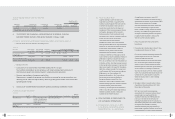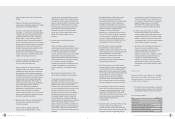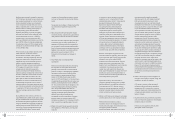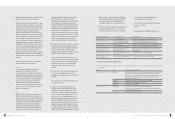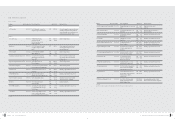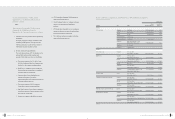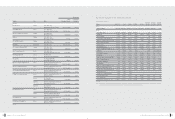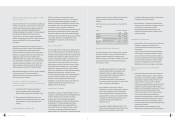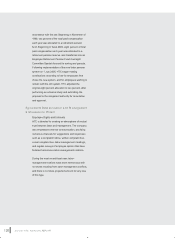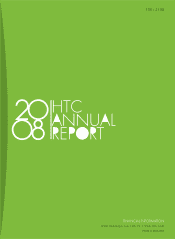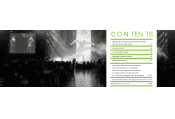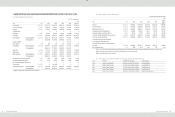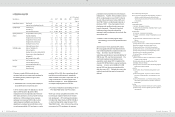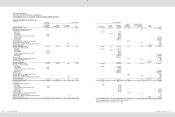HTC 2008 Annual Report Download - page 65
Download and view the complete annual report
Please find page 65 of the 2008 HTC annual report below. You can navigate through the pages in the report by either clicking on the pages listed below, or by using the keyword search tool below to find specific information within the annual report.
VII. AFFILIATE IN FO RM ATIO N AN D O THER SPECIAL N O TES
125
installed pollution control equipment. HTC further
implements internal training programs and conducts audits
to ensure relevant pollution control mechanisms operate
properly and effectively in order to continue reducing
pollution at HTC. HTC regularly contracts with licensed
independent inspectors to review its operational
environment. Every audit and inspection of HTC facilities
conducted since HTC was founded has confirmed that
company operations comply with all relevant government
rules and regulations. The environmental management
systems currently in place at HTC were accredited under
ISO-14001:2004 in an effort to enhance management
effectiveness and achieve 'clean production' objectives.
1. Losses (including financial compensation) and
fines due to pollution incidents from the start of
the most recent fiscal year up to the date of report
publication:
HTC has never been fined or otherwise penalized for
pollution by environmental authorities.
2. Future strategies (inclusive of Environmental
Protection facility improvements) and planned
expenditures:
>Continue to strengthen operations management to
comply with government rules / regulations and
reduce the occurrence of abnormalities.
>Strengthen waste collection and recycling efforts.
Encourage resource reuse as part of efforts to
achieve waste volume reduction targets.
>Continue to promote implementation and operation
of ISO-14001 environmental management systems.
Achieve 'green' environmental goals leveraging both
technology and management.
>Major planned environmental expenditures over the
next 2 years include:
124
Consolidated Financial Statements of HTC
Affiliated Companies
Pursuant to the Regulations Governing Preparation of
Consolidated Business Reports Covering Affiliated
Enterprises, Consolidated Financial Statements Covering
Affiliated Enterprises, and Reports on Affiliations and to
Letter No. Taiwan-Finance-Securities-04448 of the
Securities and Futures Commission, Ministry of Finance,
HTC shall prepare the affiliates' consolidated financial
statements and issue the declaration of Attachment 1 of
that Letter. That declaration has already been issued by
HTC and placed on page 1 of the affiliates' financial
statement; please refer to it there.
Affiliates Report
There were no circumstances requiring preparation of an
Affiliates Report.
2. PRIVATE PLACEMENT SECURITIES
IN 2008 AND AS OF THE DATE OF
THIS ANNUAL REPORT:
None.
3. STATUS OF HTC COMMON
SHARES AND GDRS ACQUIRED,
DISPOSED OF, AND HELD BY
SUBSIDIARIES:
None.
4. ANY EVENTS IN 2008 AND AS OF
THE DATE OF THIS ANNUAL
REPORT THAT HAD SIGNIFICANT
IMPACTS ON SHAREHOLDERS'
RIGHT OR SECURITY PRICES AS
STATED IN ITEM 2 PARAGRAPH 2
OF ARTICLE 36 OF SECURITIES
AND EXCHANGE LAW OF TAIWAN:
None.
5. OTHER NECESSARY SUPPLEMENT:
Key Functionalities and Manufacturing
Processes for Primary Product Lines:
HTC's main products are handheld devices and Windows
Mobile and Android operating systems based wireless
equipment, including their design, production, and
manufacturing. The main applications for those products
are personal calendar and name card management,
multimedia entertainment, meeting records, pending
project reminders, the sending/receiving of e-mail, real-time
information searches, financial transactions, data base
management, medical history information access, and
process control management.
•The workflow for handheld devices, from
R&D through production, is as follows:
2009 Environmental Protection Expenditures
Primary products manufactured by the HTC Corporation
include personal data assistant (PDA) and converged
phone products. With regard to production processes,
airborne pollutants are an issue of concern only during
soldering work and solid wastes are generated at various
production stages. HTC production processes generate no
wastewater.
HTC places a high priority on effectively managing wastes
generated by operations, and consistently allocates
significant funds to install and maintain pollution prevention
facilities and retain professional staff. HTC provides offsite
training for staff to earn licenses needed to operate
2OO 8 HTC AN N UAL REPO RT
Setting Product Specifications
Software/Hardware R&D
Testing
Certification
Substrate Manufacturing
Substrate Testing
System Assembly
Finished Product Testing & Inspection
Finished Product Enters
Anticipated
Equipment
Purchases /
Expenditures
Anticipated
Benefits
1. Install oil-water separation system at old
2. Water reduction campaign:
implementation & promotion.
3. Install heat pump system in dormitories.
1. Improve quality of kitchen wastewater;
2. Enhance awareness of / attitudes toward
energy conservation; improve water
conservation facilities; encourage
collective efforts for significant results;
3. Heat pumps help reduce electricity
demand.
1. Roll out of new solar power generation system;
2. Incorporate environmentally friendly materials
in new administrative building construction;
3. Install energy saving light fixtures, independent
power controls and energy saving sensor light
switches;
4. Install water saving devices;
5. Roll out of energy saving air conditioning
equipment;
6. Install converters on elevators and air
compressors;
7. Implement rainwater collection & recycling;
8. Install new wastewater handling facilities.
1. Use of solar energy reduces need for electricity
generated by carbon fuels and related pollution /
environmental impacts;
2. Use of environmentally friendly (green) materials
& energy saving light fixtures reduces power use.
3. T5 low EMF, low temperature light tubes reduce
energy waste. Independent switches for each light
fixture allows switch on only when needed to save
on energy;
4. Water saving taps and dual flush systems in
lavatories, washrooms, kitchenettes and
bathrooms reduce water use and waste.
5. Aircon temperature controls upgraded with on/off
timers & converters to save energy;
6. Elevators & compressors upgraded with
converters to save energy;
7. Rainwater recycling;
8. Upgraded wastewater handling facilities further
reduces waterborne emissions into the environment.
1. Continued roll out of new solar power generation system;
2. Install environmentally friendly materials (e.g., recycled
floorboards, double low e glass) in new admin building;
3. Continue to install power saving light fixtures and sensor
switches;
4. Continue to install water saving devices;
5. Continue to install power saving air conditioning equipment;
6. Continue to install converters on elevators and air
compressors;
7. Continue to install rainwater collection & recycling systems;
8. Install wastewater handling facilities;
9. Install heat pump system in dormitories.
1. Solar energy helps reduce pollution and
environmental / ecological damage;
2. Green materials meet environmental protection
requirements and reduce heat transfer to save energy;
3. T5 low EMF, low temperature light tubes reduce energy
waste. Independent switches for each light fixture allows
switch on only when needed to save on energy;
4. Water saving taps and dual flush systems in
lavatories, washrooms, kitchenettes and bathrooms
reduce water use and waste.
5. Aircon temperature controls upgraded with on/off
timers & converters to save energy; 6. Elevators &
compressors upgraded with converters to save energy;
6. Elevators & compressors upgraded with
converters to save energy;
7. Rainwater recycling;
8. Upgraded wastewater handling facilities further
reduces waterborne emissions into the environment;
9. Heat pumps help reduce electricity demand.
Item 2009 2010 2011
TOTAL 16,000 70,800 25,000
'0 8A R_ HT C/ 英文版* NEW 05/ 21/ 20 09 11: 44 頁面 12 4



